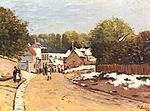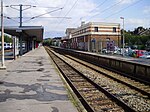Cimetière de Louveciennes
Buildings and structures in YvelinesCemeteries in Île-de-FranceEuropean cemetery stubsFrench building and structure stubsTourist attractions in Yvelines

The Cimetière de Louveciennes (Louveciennes Cemetery), also Cimetière des Arches, is made up of a standard laid out cemetery and a landscaped cemetery located on the Allée des Arches in the village of Louveciennes in the Yvelines département of France. The village is at the western suburbs of Paris and is between Versailles and Saint-Germain-en-Laye, and adjacent to Marly-le-Roi. Both of the Louveciennes cemeteries are bordered by a 650-metre portion of the Louveciennes Aqueduct originally built in 1684 by Jules Hardouin Mansart to supply the Palace of Versailles with water.
Excerpt from the Wikipedia article Cimetière de Louveciennes (License: CC BY-SA 3.0, Authors, Images).Cimetière de Louveciennes
Allée des Arches, Saint-Germain-en-Laye
Geographical coordinates (GPS) Address Nearby Places Show on map
Geographical coordinates (GPS)
| Latitude | Longitude |
|---|---|
| N 48.8642 ° | E 2.11 ° |
Address
Allée des Arches
Allée des Arches
78430 Saint-Germain-en-Laye
Ile-de-France, France
Open on Google Maps









